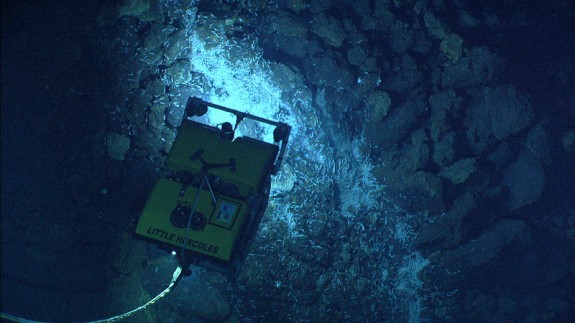Scientists Pluck Blind Shrimp and Other Strange Life Forms From World’s Deepest Hydrothermal Vent
More than three miles beneath the waves, the world’s deepest hydrothermal vent is home to ghostly creatures

A robotic sub navigates the Cayman Trough during a separate expedition in 2011. Photo: NOAA Ocean Explorer
At the depths of the deep ocean, a British team in command of a robotic submarine, discovered the world’s deepest known hydrothermal vent system—a series of smoking towers of accumulated rock and metal some three miles below the waves. The hydrothermal vents were found in the Cayman Trough, a deep sea ridge in the Caribbean Sea, where they extrude water laced with rock and metal at temperatures more than 750 Fahrenheit, says the BBC.
First discovered in the 1970s, says Peter Rona, a hydrothermal vent scientist, in an interview with this author, such deep sea vents are important for “exchanging heat and chemicals between the Earth’s interior and the oceans.” On top of their role in the larger processes that drive and shape the Earth, hydrothermal vents are also home to a unique array of life forms, animals that thrive by deriving their energy not from sunlight but from the chemicals extruded from the vents.
At the new Cayman Trough vent, the researchers found “ghostly-white shrimp – clustered on the rocks in teeming crowds.” A life in the depths, says the BBC, has seemingly left the shrimp without sight, “because their eyes are fused together.”
More from Smithsonian.com:
/https://tf-cmsv2-smithsonianmag-media.s3.amazonaws.com/accounts/headshot/smartnews-colin-schultz-240.jpg)
/https://tf-cmsv2-smithsonianmag-media.s3.amazonaws.com/accounts/headshot/smartnews-colin-schultz-240.jpg)